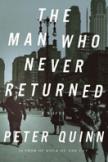Disappearing Act
For people of a certain age, this book’s title might evoke expectations about the famous Charlie, celebrated in the Kingston Trio song of the late 1950s, who was condemned to “ride forever ‘neath the streets of Boston” because he had no subway exit fare on the M.T.A. Instead, it refers to the far more famous Judge Joseph Force Crater, newly appointed to the New York State Supreme Court, who suddenly vanished after entering a taxi on New York City’s West side on the evening of Aug. 6, 1930.
The disappearance of Judge Crater (like that of Amelia Earhart a few years later) fascinated the nation at the time, and an endless offering of rumors, speculations and theories filled the tabloid newspapers. Sightings of Judge Crater were reported countrywide (on bread lines in Chicago or Detroit, in Hooverville shacks in Seattle, on farms in Nebraska), and many a corpse was exhumed on a knowing but false tip. Franklin D. Roosevelt (then New York’s governor) was behind the disappearance, or else the mob or a jealous husband or perhaps rival politicians or the New York Police Department. For decades later, until as recently as 1980, on each five-year anniversary, some newspaper somewhere in the United States would resuscitate the story under the familiar banner, “Where Is Judge Crater?”
Peter Quinn has masterfully revived the mystery of Judge Crater and the atmospherics of the Depression-era 1930s and interwoven them with clever revivals of film noir-like characters and suspense, layering mystery upon mystery in enthralling fashion. His central character, Fintan Dunne, is an Irish reincarnation of a Humphrey Bogart-like, somewhat noble but ever-skeptical Sam Spade or Philip Marlowe. The year is 1955 and Dunne, who first appeared as a New York detective in Quinn’s fine thriller Hour of the Cat (2005), is now retired in Florida after a career in the Office of Strategic Services in World War II and as a private investigator. Though reasonably content in retirement, he is gradually lured back into the investigative game by ex-O.S.S. pals when, to his surprise, he is offered a considerable fee if he can solve the 25-year-old mystery of Judge Crater. The offer comes from the newspaper tycoon Walter Wilkes, monomaniacal dispenser of sleaze journalism, who plans to have Dunne’s solving of the Crater mystery coincide with the launching of his new glossy magazine, Snap, and that of a third television network on the Aug. 6 anniversary.
The reader thereafter accompanies Dunne on his quest, a Dantesque descent into the past (the hellish world of Gotham in the early 1930s), wedding history and mystery—Quinn’s novelistic strengths—and the equally baffling present of 1955 with its distorted memories and updated resentments. Everything grows curiouser and curiouser as Dunne visits the over- and underworld of a marvelous cast of characters: elusive ex-cops, bitter former showgirls, a still-aggrieved widow, a nasty coroner, a shrewd and helpful nurse and several reluctant witnesses from long ago. Throughout, the dialogue is witty and pointed, never self-consciously cute, while ever so subtly the clues mount into coherence and readerly satisfaction.
Quinn is an unobtrusive but sure-handed guide. The chronological narrative is artfully balanced and buttressed by clever insertions of seemingly verbatim excerpts that consist of “reprints” from various magazines, newspaper articles, interviews and books. These inserts are, like the story itself, history re-imagined and contribute another layer to this novel’s pleasures. They are then reinforced by pertinent quotations from the Gideon Bible Dunne peruses, notably one citation from Ecclesiastes that captures succinctly the novel’s theme: “For God will bring every work into judgment, including every secret thing, whether good or evil.” In this novel, God does so.
This article also appeared in print, under the headline “Disappearing Act,” in the October 4, 2010, issue.








